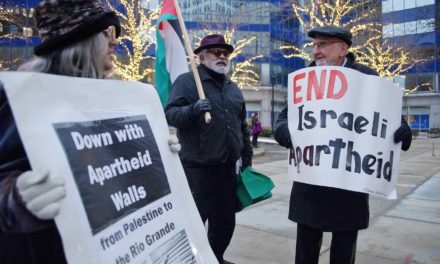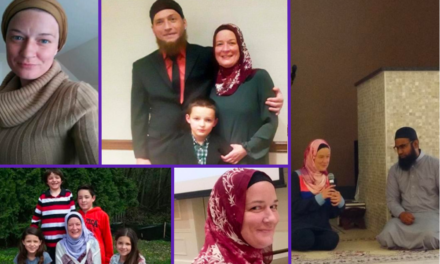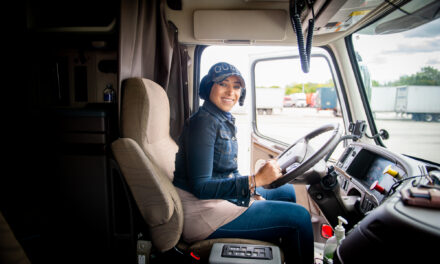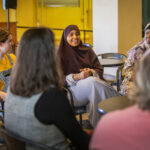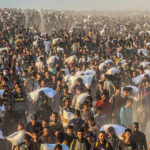Milwaukee Muslim Women’s Coalition and Hanan Refugee Relief Services collect donations for Ft. McCoy’s Afghan guests. “The response from the Milwaukee community, churches and organizations has been tremendous,” said Sheila Badwan of Hanan Refugee Relief Group.
The Milwaukee Muslim Women’s Coalition made the unprecedented move last Saturday to gain permission, with the assistance of U.S. Rep. Gwen Moore (D-Wis.), to tour Ft. McCoy and see for themselves the conditions of the 12,700 evacuees from Afghanistan temporarily housed there. U.S. Reps. Moore and Ilhan Omar accompanied the delegation.
A two-week U.S. airlift out of Afghanistan in August of tens of thousands of Afghans, along with Americans, ended the 20-year war against the Taliban. About 90,000 Afghan evacuees are now being housed at U.S. military bases in the United States and overseas.
Reports of a lack of clothing, halal food and privacy on U.S. bases led the MMWC leadership to visit Ft. McCoy. MMWC partnered with Hanan Refugee Relief Group to assess the needs of the Afghans housed at Fort McCoy and to better understand how they can assist them in the months ahead. They also delivered a truck full of clothing, prayer rugs, Qur’ans and other items they had been gathering for the prior two weeks. This was the third truckload the MMWC sent to Fort McCoy. All of the new items were donated by groups from across Wisconsin.
“The other purpose was to welcome the guests and provide them with emotional support at this time, to give them the opportunity see somebody who looks like them,” said Inshirah Farhoud, former MMWC vice president and a pediatric nurse practitioner, certified in psychiatry.
Wisconsin Muslim Journal interviewed members of the visiting delegation to report what they learned about the needs of the Afghan guests.
Inside Ft. McCoy
A delegation of 10 Wisconsin Muslim women, joined by U.S. Reps. Gwen Moore and Ilhan Omar, visited Ft. McCoy Saturday to meet the Afghans temporarily housed there. During the four-hour visit, the delegation was briefed by military and government representatives and toured the base. A small group that included the two congresswomen and MMWC President Janan Najeeb sat with a group of six Afghan women for a discussion that lasted about an hour and a half.
“The congresswomen and I sat with six notable Afghan women who formerly held high positions in medicine, media, technology, economy and education,” Najeeb said. “It was a very heartfelt and open conversation. Each of the women shared about their life and accomplishments, their fears for friends and family remaining in Afghanistan and concern for the women that remained. They shared that they had just heard schooling for females above 6th grade was stopped. They were concerned about the future of Afghanistan and how the lack of funding to Afghanistan will cause an economic collapse and result in deep suffering of civilians.

An Afghan woman at Ft. McCoy selects clothing for her family.
“We also heard their perspective about the experience at Ft. McCoy, the dire need for trauma care that is culturally informed, and the need for regular classes and schooling for the children there rather than the volunteer-led teaching they now have that is very limited.
“Since the Afghans have a lot of time right now with nothing to do, they asked for English classes and sessions on cultural understanding so the evacuees could understand how to live in America, the laws and rules and social practices they will encounter, so it will not be a major culture shock when they leave the base.”
The Muslim women who visited the base said they felt both relief and concern about what they saw.
“Right when we hit the ground, we saw refugees strolling down the street, some sitting on lawns, children playing,” said Dr. Aishah Aslam, a Milwaukee cardiologist.
About 45% of the Afghans on the base are children, said Sheila Badwan, the lead of Hanan Refugee Relief Group’s Milwaukee Chapter.

Soldiers play tag with Afghan children at Ft. McCoy, near Tomah, Wisconsin.
“It’s pretty spread out but there is not much there, just barracks and lawn,” Aslam continued. “It was nice to see military personnel on the base interact with people, especially the children. I did not see any type of animosity toward the refugees. You never got the impression the Afghan guests were uncomfortable around the soldiers.
“Many of the soldiers had been in Afghanistan. One of the soldiers I met said he had worked with an interpreter in Afghanistan, didn’t know what had happened to him, then he met him here at Ft. McCoy. He was so happy and he is actually working on sponsoring him. I thought that was really really cool to have that kind of connection.
“We saw kids playing,” Farhoud said.” We saw women hanging laundry on clotheslines. The first thing I thought was, oh, no, they don’t have dryers, but I learned they did. It was just that they preferred to hang their laundry, so the military had clotheslines put up just for them.
“We saw men and women on cellphones and I was surprised to see that. They have internet but they didn’t have a wide-enough bandwidth initially, so it was increased because they all have cellphones.”
One concern Farhoud had was about the housing situation. “They have 72 people in each barrack, 36 on each floor. The barracks are two-story, with just beds with bathrooms at the end of each hall, with the bathroom on one floor for men and the other for women.” Cloth barriers were put between each family she said, so they have some privacy.
“I just think how difficult it is for a child to go to the bathroom in the middle of the night or even a mom to go past people who are sleeping.”
In the briefing, Farhoud said she learned that the conditions at Ft. McCoy are better than at other bases. “I really felt heartbroken to see them there. But once they told us this was a better place than others, I felt they are lucky. They are safer than they were before. They know where their next meal is coming from.”

Military bases are now serving halal meals and familiar spices to Afghan guests.
She learned the staff at Ft. McCoy had little time to prepare before the refugees came in, only days. Likewise, the refugees had to flee Afghanistan quickly.
“I was pleasantly surprised in terms of the current conditions there,” said Dr. Aslam. “They seemed organized and receptive to the needs of the refugees. They were adapting to this crazy scenario where they had a huge influx. Initially, we were told there were 6,000 refugees there, then we were surprised when we were told there are actually 12,690.”
Addressing medical needs
Dr. Aslam asked to see the medical facilities. She saw a small, clean clinic that was staffed by a private contractor. “They said they see 200 to 300 patients a day,” she said. “They are also able to send them to local hospitals if needed.
Dr. Aslam was pleased to see they had designated a separate building for dealing with behavioral and mental health issues, and they have a soldier designated as a contact for women with concerns about women’s issues.
Addressing the trauma
Farhoud also wanted to see how mental health issues are being addressed. “As a psychiatric nurse practitioner, how their mental health was affected is a concern. I asked everyone, ‘What are you doing about the trauma experienced by these kids?’”
She was told mental health “first aid” started last week and that trauma was being addressed,” she said.
Being among the Afghan evacuees, especially the children, brought childhood memories to mind, Farhoud said. In the 1967 War, she recalled fleeing from Elbireh, Palestine, to Jordan with her parents. Only 9 years old at the time, she remembers, “bombs on top of our heads, crossing the Jordan River on my uncle’s shoulders, spending nights in caves. To this day, it is very traumatic to remember.
“Can you imagine what it is like for these kids and adults who have been in war for years? When we went from Palestine to Jordan, we knew the language and the culture, but these kids don’t know either one and they can’t go back.”
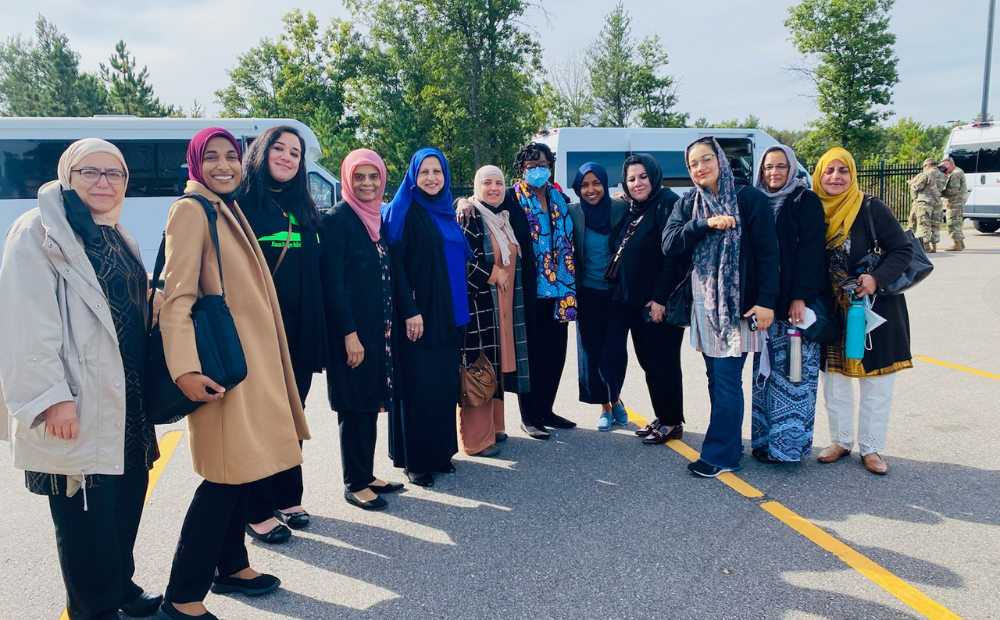
(From left to right) Inshirah Farhoud, Aishah Aslam, Sheila Badwan and (fifth from the left) Janan Najeeb spoke with the Wisconsin Muslim Journal about their visit to Ft. McCoy. Others from MMWC and the Hanan Refugee Relief Group, U.S. Reps. Gwen Moore and Ilhan Omar and interpreters are also shown.
Warm clothing, coats and boots urgently needed
“As we were walking past the barracks,” Farhoud said, “our interpreters asked them simple questions like, ‘How are you doing?’ and ‘Are you happy?’
“One message that came through loud and clear was that they were cold.”
“I noticed people who were wearing sandals or blankets,” said Badwan of Hanan Refugee Relief Group. “So, the urgent need right now is definitely winter items, winter gear, boots, winter jackets.”
Badwan is happy that the Milwaukee community has rallied to support the refugees. Churches and local non-profit organizations like Hunger Task Force have collaborated with a drive organized by Hanan Refugee Relief Group and MMWC. Organizations drop off donations of new clothing for all ages and other items to the MMWC, 5235 S 27th St., Greenfield. Trucks pick up donations on Fridays and deliver them to Ft. McCoy on Saturdays.
That program is continuing, Badwan said. In addition, cash donations are used to buy clothing from wholesale sellers in Chicago. In addition, some merchants are donating, she said, citing Wantable, an e-commerce business based in Milwaukee, that “has donated palates and palates of new clothing.”
Housing, immigration status and the future
As the Afghan guests are processed into communities, “the biggest concern ahead is housing,” Badwan said. “In today’s tight housing market, some people are offering their finished basements to house families. Others have offered temporary housing while permanent situations are found.”
There are some unaccompanied minors in the group that are being managed by the State Department’s Office of Resettlement of Refugees, Dr. Aslam said. “That is something we will want to follow,” she said.
Dr. Aslam also shared the news she heard at the briefing at Ft. McCoy about a website offering additional ways to help. The State Department is partnering with Welcome.US, a non-profit, non-partisan initiative to galvanize additional private sector support for arriving Afghans.
One concern is the immigration status given to each Afghan evacuee, members of the delegation agreed. Some have Special Immigration Visas that have been processed and they will be able to move out quickly, especially if they have U.S. contacts who are helping them. Others are in the process of completing their SIV status, delegates were told. Yet, the vast majority have “humanitarian parole” status with limited benefits, said Badwan. Meeting their needs will be a priority.
MMWC plans to follow up on this issue, Najeeb said. “We left our information with officials as well as some of the guests. We plan to follow up and to make additional trips in the future.
“We would like officials to realize that they have important and culturally informed resources in their backyard. We have tremendous expertise in working with women as well as teaching cultural competency.
“We hope when we return that every guest has a couple of changes of clothes, more ethnically appropriate food choices and culturally informed mental health and trauma care.”
Photos courtesy of the Defense Visual Information Distribution Service.

